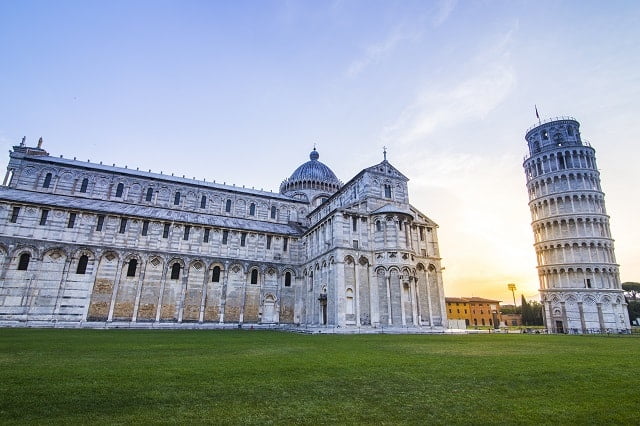Are you planning a trip to Italy and want to learn some essential Italian phrases? One of the first things you might want to know is how to say “travel” in Italian.
In this article, we will explore the basics of the Italian language, including verbs and nouns, as well as essential travel vocabulary and common phrases. Whether you’re a beginner looking to communicate during your trip or simply interested in learning a new language, this article will guide you through the world of Italian travel language.
The Italian language is known for its melodious sound and rich cultural heritage. Understanding the basics of Italian, such as verbs and nouns, is crucial for anyone looking to communicate effectively while traveling in Italy. In addition to language fundamentals, having a grasp of travel-specific vocabulary will greatly enhance your experience abroad. From asking for directions to ordering food at a restaurant, knowing key phrases in Italian can make your journey more enjoyable and immersive.
In this article, we will tackle the question: “How do you say travel in Italian?” We’ll delve into the translation of the word “travel,” along with common travel phrases that tourists can use during their visit. By embracing the Italian language and culture through travel, you can create meaningful connections with locals and gain a deeper understanding of this captivating country. So let’s begin our exploration of the beautiful Italian language.
The Basics of Italian
Verbs and nouns are essential components of any language, including Italian. Understanding these basic elements is crucial for building a solid foundation in the Italian language. In Italian, verbs are used to express actions, while nouns are used to identify people, places, things, or ideas.
When it comes to verbs in Italian, there are three main categories: – are, – ere, and – ire. These endings indicate the infinitive form of the verb. For example, the verb “to travel” in Italian is “viaggiare,” which ends in – are. This pattern applies to many other common verbs in Italian as well. It is important to understand these verb endings when conjugating verbs for different subjects and tenses.
Nouns in Italian also have gender (masculine or feminine) and number (singular or plural). It is important to pay attention to these distinctions when using nouns in sentences. For instance, the word for “travel” in Italian is “viaggio,” which is masculine and singular. When talking about multiple travels or trips, the word becomes “viaggi,” with a slightly different ending to indicate plurality. Understanding how nouns change based on gender and number is vital for constructing grammatically correct sentences in Italian.
Overall, gaining a strong grasp of verbs and nouns is fundamental for anyone learning the Italian language. Knowing how to correctly use and conjugate verbs and navigate gender and number variations with nouns will greatly improve one’s ability to communicate effectively in Italian.
Travel Vocabulary in Italian
When visiting Italy, it’s always helpful to have a basic understanding of the Italian language, especially when it comes to essential travel vocabulary. Whether you’re navigating the bustling streets of Rome or ordering a cappuccino in a quaint café in Florence, having some key words and phrases at your disposal can greatly enhance your travel experience. In this section, we’ll explore some must-know Italian travel vocabulary to help you communicate effectively during your time in Italy.
Common Words and Phrases
One of the first things you’ll want to familiarize yourself with are common words and phrases that will come in handy while traveling through Italy. For instance, “hello” is translated as “ciao,” “thank you” is “grazie,” and “please” is “per favore.” Mastering these basic expressions can go a long way in making interactions with locals more pleasant and respectful.
Transportation Terms
Understanding transportation terms is crucial for getting around efficiently in any country. In Italian, “airport” is “aeroporto,” “train station” is “stazione ferroviaria,” and “bus stop” is “fermata dell’autobus.” Knowing these terms will not only help you navigate public transportation but also assist you in asking for directions when needed.
Dining Out
When it comes to dining out, knowing how to order your favorite Italian dishes or ask for the check can be quite useful. For example, “menu” translates to “menu,” “water” is “acqua,” and if you need the bill, simply ask for it by saying “il conto, per favore.” Having a grasp of these dining-related phrases can make your culinary experiences in Italy even more enjoyable.
By familiarizing yourself with essential travel vocabulary in Italian, you can ensure a smoother and more enriching travel experience in this beautiful Mediterranean country. Remember that language barriers can often be bridged with just a few simple words or phrases, so don’t be shy about practicing your newfound linguistic skills during your Italian adventure.
How Do You Say Travel in Italian
Traveling to Italy and immersing yourself in the language and culture can be an enriching experience. When it comes to expressing the concept of travel in Italian, the word you would use is “viaggiare.” This verb encompasses the action of traveling, whether it’s by car, train, plane, or any other mode of transportation. Understanding how to say travel in Italian is just the beginning of your linguistic journey in this beautiful language.
In Italian, verbs are conjugated based on the subject pronoun and tense, so “viaggiare” will change depending on who is doing the traveling and when it is happening. For example, “I travel” would be “io viaggio,” while “we will travel” is “noi viaggeremo.” Additionally, nouns related to travel such as “viaggio” (journey) or “vacanza” (vacation) are essential for building your travel-related vocabulary in Italian.
Learning how to say travel and other related words in Italian will not only help you communicate effectively during your trip but also show respect for the local culture. By embracing the language as part of your travel experience, you can connect with locals on a deeper level and gain a better understanding of the country’s customs and traditions.
| Italian Word | English Translation |
|---|---|
| Viaggiare | To Travel |
| Viaggio | Journey |
| Vacanza | Vacation |
Common Italian Travel Phrases
When preparing for a trip to Italy, it’s important to learn some common Italian travel phrases that will help you communicate effectively during your visit. Whether you’re asking for directions, ordering food at a restaurant, or simply greeting locals, having a basic understanding of Italian expressions can enhance your travel experience. Here are some useful phrases to familiarize yourself with before embarking on your Italian adventure.
which means “How much does it cost?” This can be useful when shopping or dining out, allowing you to inquire about prices without any confusion. Additionally, familiarizing yourself with simple greetings such as “Buongiorno” (good morning) and “Grazie” (thank you) can go a long way in showing respect for the local culture.
Furthermore, knowing how to ask for help in Italian can be essential while traveling. Phrases like “Mi scusi” (excuse me), “Parla inglese?” (Do you speak English?), and “Mi aiuti per favore” (Can you help me please?) can aid in overcoming language barriers and seeking assistance from locals. By learning these basic expressions, you’ll not only be able to navigate through Italy more smoothly but also create meaningful interactions with the people you encounter along the way.
In addition to mastering these fundamental phrases, consider practicing your pronunciation and intonation to improve your communication skills in Italian. By doing so, you’ll feel more confident engaging with locals and immersing yourself in the rich culture of Italy. So when someone asks you, “How do you say travel in Italian?” You’ll be ready to reply with confidence: “Viaggiare”.
Italian Travel Etiquette
When traveling to Italy, it is important to be mindful of the cultural norms and etiquette that are prevalent in the country. Understanding and respecting these customs can enhance your experience and make your interactions with locals more pleasant. From greetings to dining customs, here are some cultural tips for visitors in Italy.
Greetings and Personal Space
In Italian culture, greetings are a fundamental part of social interactions. When meeting someone for the first time or entering a shop or restaurant, it is customary to greet people with a handshake and a friendly “buongiorno” (good morning) or “buonasera” (good evening).
Italians value personal space and tend to stand closer when speaking than people from other cultures might be used to. It is important to respect this closeness and not back away, as doing so can be interpreted as rude.
Dining Etiquette
Italian cuisine is world-renowned, and dining in Italy is an experience not to be missed. When dining out, it is essential to remember that Italians take their meals seriously. Tipping in Italy is not as common as it is in other countries, as service charges are often included in the bill. Table manners are also crucial, such as keeping your hands on the table at all times (not on your lap) and refraining from putting bread on your plate.
Dress Code
Italians take pride in their appearance, and dressing smartly is often appreciated when visiting various establishments. While casual attire is acceptable in many places, more upscale restaurants or theaters may have dress codes that require proper attire. It’s always a good idea to check ahead of time if you’re unsure about what to wear to a specific event or venue.
By familiarizing yourself with these cultural tips before embarking on your journey to Italy, you can ensure that you have a respectful and enriching travel experience while also forging meaningful connections with locals. Traveling goes beyond sightseeing; it’s about understanding the culture of the country you’re visiting – including how do you say travel in Italian.
Italian Travel Destinations
Italy is a country filled with breathtaking destinations that anyone visiting the country should not miss. Whether you’re into historical landmarks, stunning architecture, beautiful beaches, or delicious cuisine, Italy has something for everyone. Here are some must-visit places in Italy that will surely make your trip an unforgettable experience:
Rome
Rome is the capital city of Italy and is known for its rich history, iconic landmarks, and ancient ruins. Visitors can explore famous attractions such as the Colosseum, Roman Forum, Pantheon, and Vatican City. Don’t forget to toss a coin into the Trevi Fountain to ensure a return trip to this enchanting city.
Florence
Florence is a city in the Tuscany region of Italy and is celebrated for its Renaissance art and architecture. The city is home to renowned masterpieces such as Michelangelo’s David, Brunelleschi’s Duomo, and Botticelli’s Birth of Venus. Visitors can also stroll through the charming streets of Florence and indulge in delicious Tuscan cuisine.
Venice
Venice is a unique city built on water with its iconic canals, bridges, and grand palaces. Visitors can take a gondola ride through the picturesque waterways or visit famous landmarks such as St. Mark’s Square, Doge’s Palace, and Rialto Bridge. Don’t miss the opportunity to attend the annual Venice Carnival for an unforgettable experience.
Exploring these incredible Italian travel destinations will not only provide you with memorable experiences but also give you insight into the rich history and culture of Italy itself.
Overall Visiting all three of these cities will give visitors diverse yet complete experience.less than 450 characters.
Conclusion
In conclusion, the Italian language is a beautiful and expressive way to connect with the rich culture and history of Italy. By learning basic verbs and nouns, expanding travel vocabulary, and understanding common phrases, travelers can enhance their experience and better communicate with locals. It’s not just about knowing how do you say travel in Italian, but also about immersing oneself in the language and etiquette of the country.
Visiting Italy is not just about seeing famous landmarks or tasting delicious cuisine; it’s about embracing the Italian way of life. Whether it’s enjoying a leisurely passeggiata down charming streets or savoring a flavorful gelato while conversing with locals, travelers can truly experience the essence of Italy by embracing its language and culture.
Ultimately, by exploring Italian travel destinations and familiarizing oneself with the nuances of the language, travelers can gain a deeper appreciation for this fascinating country. So, whether you’re planning your first trip to Italy or simply want to enrich your understanding of the Italian language, immersing yourself in all aspects of travel will undoubtedly enhance your overall experience.
And remember – when in doubt about how do you say travel in Italian or any other phrase, don’t be afraid to ask locals for help.
Frequently Asked Questions
What Is the Verb for Travel in Italian?
The verb for “to travel” in Italian is “viaggiare.” It is a regular first-conjugation verb, and its conjugation changes according to the subject of the sentence.
How Do You Say Travel in Italy?
In Italy, the word for “travel” is “viaggio.” This can refer to both the act of traveling and the actual journey or trip itself. Italians love to travel and explore different places.
What Is the Italian Word for Touring?
The Italian word for “touring” is “girare.” This can refer to going on tours or simply moving around and exploring different areas. Italy’s rich history and beautiful landscapes make it a popular destination for touring.

I’m a passionate traveler, writer, and Italophile. My fascination with Italy’s history, art, and culture has led me on countless adventures across the Italian landscape. Through “I Live Italy,” I share my love for this extraordinary country and aims to inspire others to explore its boundless beauty.





